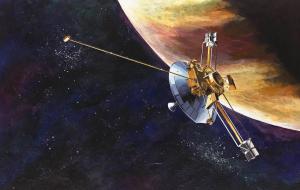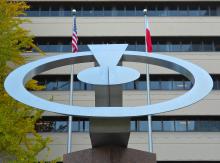This artist's concept depicts Pioneer 10 flying past Jupiter 50 years ago. It was the first mission to the giant planet, and revealed new details about its atmosphere, its magnetic and gravitational fields, its radiation belts, and its moons. [NASA]
You are here
First at Jupiter
Jupiter is like an old friend these days. We see sharp pictures of its clouds and moons all the time. Several spacecraft have flown by or entered orbit, revealing details about Jupiter’s interior, its atmosphere, its radiation belts, and more. The first of those visitors paid a call on Jupiter 50 years ago today. It greatly enhanced our knowledge of the planet, while pioneering the way for more sophisticated missions in the following decades.
Pioneer 10 flew just 81,000 miles from Jupiter on December 3rd, 1973. By then, it had traveled farther than any spacecraft in history.
During an encounter that lasted for several weeks, Pioneer 10 snapped about 500 pictures of Jupiter and some of its moons. They were crude by modern standards, but they were sharper than anything available from telescopes on Earth.
Pioneer also measured Jupiter’s magnetic and gravitational fields, and probed its atmosphere. It found that the planet’s radiation belts were at least 10,000 times as intense as Earth’s. In fact, they knocked out Pioneer’s camera.
The Jupiter encounter was the end of Pioneer 10’s main mission. Yet the craft kept working for another 20 years. It told us about conditions beyond the realm of the planets — more discoveries from a solar-system pioneer.
Jupiter is in the east at nightfall, and looks like a brilliant star — a world we began to really get to know with the visit of Pioneer 10.
Script by Damond Benningfield
Get Premium Audio
Listen to today's episode of StarDate on the web the same day it airs in high-quality streaming audio without any extra ads or announcements. Choose a $8 one-month pass, or listen every day for a year for just $30.







